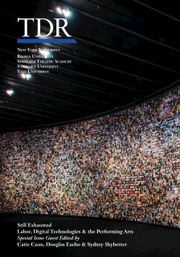No CrossRef data available.
Article contents
Nathaniel Mackey and M. Lamar
Re-memberment in the “Republic of Nub”
Published online by Cambridge University Press: 05 September 2025
Abstract
Putting the work of the poet Nathaniel Mackey into correspondence with that of the singer, composer, performance and video artist M. Lamar offers a unique perspective on the complex relationship between automation and possession. Mackey’s Andoumboulou and Mu move in and through M. Lamar so that possession and automation are destabilized and replaced by molecular distintegrations of plantation worlds and the sonic apertures of a Black Afrofuturist Android.
Information
- Type
- Article
- Information
- TDR , Volume 69 , Issue 3: Performance, Possession, and Automation Brown University TDR Consortium Issue , September 2025 , pp. 89 - 101
- Copyright
- © The Author(s), 2025. Published by Cambridge University Press on behalf of New York University Tisch School of the Arts
References
Crawley, Ashon T. 2017. Blackpentecostal Breath: The Aesthetics of Possibility. Fordham University Press.Google Scholar
Giovanni, Don. 2019. “Moor Mother - Analog Fluids of Sonic Black Holes (2019).” YouTube, 8 November. www.youtube.com/watch?v=X3yJsAA-f30
Google Scholar
Duke Alumni/Lifelong Learning (Duke). 2023. “Nathaniel Mackey – Double Trio.” YouTube, 12 September. www.youtube.com/watch?v=QkSd4je6qyw&ab_channel=DukeAlumniLifelongLearning
Google Scholar
Fiori, Nicholas. 2020. “Plantation Energy: From Slave Labor to Machine Discipline.” American Quarterly 72, 3:599–79. dx.doi.org/10.1353/aq.2020.0035
CrossRefGoogle Scholar
Hobbs, Kevin Tajzea. 2023. “In Conversation with M.Lamar: Unveiling the Afrogothic.” Marrow BTS, 30 October. marrowbts.substack.com/p/in-conversation-with-m-lamar-unveiling
Google Scholar
Johnson, Paul Christopher. 2011. “An Atlantic Genealogy of ‘Spirit Possession.’” Comparative Studies in Society and History 53, 2:393–425. doi.org/10.1017/S0010417511000107
CrossRefGoogle Scholar
Lamar, M. 2019. Liner notes. Lordship and Bondage and the Birth of the Negro Superman. Bandcamp, 15 February. mlamar.bandcamp.com/album/lordship-and-bondage-the-birth-of-the-negro-superman
Google Scholar
Lamar, M. 2021. “Re-Memberments/The Demon Rising- M. Lamar with Hunter Hunt-Hendrix & James Ilgenfritz.” YouTube, 1 January. www.youtube.com/watch?v=hQGrx72phdk&t=7s&ab_channel=MLamar
Google Scholar
McMillan, Uri. 2015. Embodied Avatars: Genealogies of Black Feminist Art and Performance. New York University Press.CrossRefGoogle Scholar
Post, Tina. 2020. “Joe Louis’s Utopic Glitch.” In Race and Performance after Repetition, ed. Soyica Diggs Colbert, Douglas A. Jones Jr., and Shane Vogel, 103–26. Duke University Press.Google Scholar
Rachel, T. Cole. 2017. “M. Lamar on Being Your Own Genre.” The Creative Independent, 13 January. thecreativeindependent.com/people/m-lamar-on-being-your-own-genre/
Google Scholar
Sinclair, John. (1966) 1973. “The InterGalactic Discipline of Sun Ra.” Ann Arbor Sun, 5 September. aadl.org/node/195929Google Scholar
Tanforan, Vincent. 2024. “‘The Black Androids’: Edward Jones-Imhotep on Technology, Selfhood, and Race.” The Reed College Quest, 10 March. www.reedquest.org/articles/2024/03/10/the-black-androids-edward-jones-imhotep-on-technology-selfhood-and-race
Google Scholar
Wickstrom, Maurya. 2017. “M. Lamar: Singing Slave Insurrection to Marx.” Theatre Survey 58, 1:68–85. doi.org/10.1017/S0040557416000697
CrossRefGoogle Scholar

